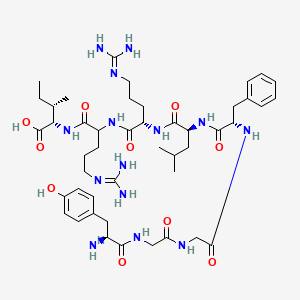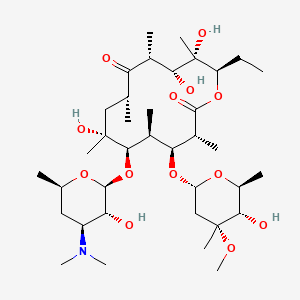
Eritromicina
Descripción general
Descripción
La eritromicina es un antibiótico macrólido que se descubrió por primera vez en 1952La this compound se utiliza ampliamente para tratar una variedad de infecciones bacterianas, incluidas las infecciones del tracto respiratorio, las infecciones de la piel, las infecciones por clamidia, la enfermedad inflamatoria pélvica y la sífilis . Funciona inhibiendo la síntesis de proteínas bacterianas, lo que evita el crecimiento de las bacterias .
Mecanismo De Acción
La eritromicina ejerce sus efectos uniéndose a la subunidad ribosómica 50S de las bacterias, lo que inhibe la síntesis de proteínas. Esta acción evita la elongación de la cadena peptídica, lo que detiene efectivamente el crecimiento bacteriano. El principal objetivo molecular de la this compound es el ribosoma bacteriano, y su mecanismo de acción implica bloquear el túnel de salida a través del cual pasan las proteínas recién sintetizadas .
Aplicaciones Científicas De Investigación
La eritromicina tiene una amplia gama de aplicaciones de investigación científica:
Química: La this compound se utiliza como material de partida para la síntesis de otros antibióticos macrólidos.
Biología: En la investigación biológica, la this compound se utiliza para estudiar la síntesis de proteínas bacterianas y los mecanismos de resistencia a los antibióticos.
Medicina: La this compound se utiliza ampliamente en entornos clínicos para tratar infecciones bacterianas.
Análisis Bioquímico
Biochemical Properties
Erythromycin plays a crucial role in biochemical reactions by interacting with various enzymes, proteins, and other biomolecules. It primarily targets the bacterial ribosome, specifically binding to the 23S ribosomal RNA within the 50S subunit. This binding inhibits the translocation of peptides, effectively halting protein synthesis. Erythromycin also interacts with cytochrome P450 enzymes in the liver, which are involved in its metabolism .
Cellular Effects
Erythromycin affects various types of cells and cellular processes. In bacterial cells, it inhibits protein synthesis by binding to the ribosome, leading to cell death. In eukaryotic cells, erythromycin can influence cell signaling pathways, gene expression, and cellular metabolism. For example, it has been shown to modulate the expression of genes involved in inflammatory responses and can affect mitochondrial function by inhibiting mitochondrial protein synthesis .
Molecular Mechanism
The molecular mechanism of erythromycin involves its binding to the 23S ribosomal RNA in the 50S subunit of the bacterial ribosome. This binding blocks the exit tunnel through which nascent peptides exit the ribosome, thereby inhibiting peptide chain elongation and protein synthesis. Erythromycin’s interaction with the ribosome is highly specific, and its efficacy is influenced by the presence of resistance genes that can modify the ribosomal binding site .
Temporal Effects in Laboratory Settings
In laboratory settings, the effects of erythromycin can change over time. Erythromycin is relatively stable under neutral pH but can degrade in acidic conditions. Long-term exposure to erythromycin in vitro can lead to the development of bacterial resistance, characterized by mutations in the ribosomal RNA or the acquisition of resistance genes. Additionally, erythromycin’s stability and efficacy can be influenced by storage conditions and the presence of other compounds .
Dosage Effects in Animal Models
The effects of erythromycin vary with different dosages in animal models. At therapeutic doses, erythromycin effectively treats bacterial infections without significant adverse effects. At higher doses, it can cause gastrointestinal disturbances, hepatotoxicity, and cardiotoxicity. In animal studies, erythromycin has been shown to have a dose-dependent effect on bacterial clearance and the development of resistance .
Metabolic Pathways
Erythromycin is metabolized primarily in the liver by cytochrome P450 enzymes, particularly CYP3A4. The metabolic pathways involve demethylation and hydrolysis, resulting in various metabolites that are excreted in the bile. Erythromycin can also affect the metabolism of other drugs by inhibiting CYP3A4, leading to potential drug-drug interactions .
Transport and Distribution
Erythromycin is transported and distributed within cells and tissues through passive diffusion and active transport mechanisms. It is highly protein-bound in the plasma and can accumulate in tissues such as the liver, lungs, and spleen. Erythromycin’s distribution is influenced by its lipophilicity, allowing it to penetrate cell membranes and reach intracellular targets .
Subcellular Localization
Erythromycin’s subcellular localization is primarily within the cytoplasm, where it exerts its antibacterial effects by targeting the ribosome. It can also localize to the mitochondria in eukaryotic cells, affecting mitochondrial protein synthesis. The localization of erythromycin is influenced by its chemical structure and the presence of specific transporters and binding proteins .
Métodos De Preparación
Rutas sintéticas y condiciones de reacción: La eritromicina se sintetiza típicamente a través de un proceso de fermentación que involucra la bacteria Saccharopolyspora erythraea. El proceso de fermentación implica el cultivo de la bacteria en un medio rico en nutrientes, lo que lleva a la producción de this compound. El compuesto se extrae y purifica luego a través de varios procesos químicos .
Métodos de producción industrial: En entornos industriales, la this compound se produce a gran escala utilizando tanques de fermentación. El proceso de fermentación se controla cuidadosamente para optimizar el rendimiento de la this compound. Después de la fermentación, el compuesto se extrae utilizando solventes y se purifica mediante técnicas de cristalización y filtración .
Análisis De Reacciones Químicas
Tipos de reacciones: La eritromicina experimenta varios tipos de reacciones químicas, incluidas las reacciones de oxidación, reducción y sustitución. Estas reacciones son esenciales para modificar la estructura de la this compound para producir derivados con propiedades farmacológicas mejoradas .
Reactivos y condiciones comunes:
Oxidación: La this compound se puede oxidar utilizando reactivos como el peróxido de hidrógeno o el permanganato de potasio en condiciones controladas.
Reducción: Las reacciones de reducción se pueden llevar a cabo utilizando reactivos como el borohidruro de sodio o el hidruro de aluminio y litio.
Principales productos formados: Los principales productos formados a partir de estas reacciones incluyen varios derivados de la this compound, como la azitromicina, la claritromicina y la roxitromicina. Estos derivados se han desarrollado para superar algunas de las limitaciones de la this compound, como la escasa estabilidad en condiciones ácidas .
Comparación Con Compuestos Similares
La eritromicina pertenece a la clase de antibióticos macrólidos, que incluye otros compuestos como la azitromicina, la claritromicina y la roxitromicina. Estos compuestos comparten un mecanismo de acción similar pero difieren en sus propiedades farmacocinéticas y su espectro de actividad .
Compuestos similares:
Azitromicina: Conocida por su vida media prolongada y su mejor penetración tisular.
Claritromicina: Destacada por su mayor actividad contra ciertas cepas bacterianas y su mejor estabilidad ácida.
Roxitromicina: Desarrollada para proporcionar una mejor tolerancia gastrointestinal y una vida media más larga en comparación con la this compound.
La this compound sigue siendo un antibiótico valioso debido a su amplio espectro de actividad y su papel como precursor para el desarrollo de otros antibióticos macrólidos.
Propiedades
IUPAC Name |
(3R,4S,5S,6R,7R,9R,11R,12R,13S,14R)-6-[(2S,3R,4S,6R)-4-(dimethylamino)-3-hydroxy-6-methyloxan-2-yl]oxy-14-ethyl-7,12,13-trihydroxy-4-[(2R,4R,5S,6S)-5-hydroxy-4-methoxy-4,6-dimethyloxan-2-yl]oxy-3,5,7,9,11,13-hexamethyl-oxacyclotetradecane-2,10-dione | |
|---|---|---|
| Source | PubChem | |
| URL | https://pubchem.ncbi.nlm.nih.gov | |
| Description | Data deposited in or computed by PubChem | |
InChI |
InChI=1S/C37H67NO13/c1-14-25-37(10,45)30(41)20(4)27(39)18(2)16-35(8,44)32(51-34-28(40)24(38(11)12)15-19(3)47-34)21(5)29(22(6)33(43)49-25)50-26-17-36(9,46-13)31(42)23(7)48-26/h18-26,28-32,34,40-42,44-45H,14-17H2,1-13H3/t18-,19-,20+,21+,22-,23+,24+,25-,26+,28-,29+,30-,31+,32-,34+,35-,36-,37-/m1/s1 | |
| Source | PubChem | |
| URL | https://pubchem.ncbi.nlm.nih.gov | |
| Description | Data deposited in or computed by PubChem | |
InChI Key |
ULGZDMOVFRHVEP-RWJQBGPGSA-N | |
| Source | PubChem | |
| URL | https://pubchem.ncbi.nlm.nih.gov | |
| Description | Data deposited in or computed by PubChem | |
Canonical SMILES |
CCC1C(C(C(C(=O)C(CC(C(C(C(C(C(=O)O1)C)OC2CC(C(C(O2)C)O)(C)OC)C)OC3C(C(CC(O3)C)N(C)C)O)(C)O)C)C)O)(C)O | |
| Source | PubChem | |
| URL | https://pubchem.ncbi.nlm.nih.gov | |
| Description | Data deposited in or computed by PubChem | |
Isomeric SMILES |
CC[C@@H]1[C@@]([C@@H]([C@H](C(=O)[C@@H](C[C@@]([C@@H]([C@H]([C@@H]([C@H](C(=O)O1)C)O[C@H]2C[C@@]([C@H]([C@@H](O2)C)O)(C)OC)C)O[C@H]3[C@@H]([C@H](C[C@H](O3)C)N(C)C)O)(C)O)C)C)O)(C)O | |
| Source | PubChem | |
| URL | https://pubchem.ncbi.nlm.nih.gov | |
| Description | Data deposited in or computed by PubChem | |
Molecular Formula |
C37H67NO13 | |
| Source | PubChem | |
| URL | https://pubchem.ncbi.nlm.nih.gov | |
| Description | Data deposited in or computed by PubChem | |
DSSTOX Substance ID |
DTXSID4022991 | |
| Record name | Erythromycin | |
| Source | EPA DSSTox | |
| URL | https://comptox.epa.gov/dashboard/DTXSID4022991 | |
| Description | DSSTox provides a high quality public chemistry resource for supporting improved predictive toxicology. | |
Molecular Weight |
733.9 g/mol | |
| Source | PubChem | |
| URL | https://pubchem.ncbi.nlm.nih.gov | |
| Description | Data deposited in or computed by PubChem | |
Physical Description |
Solid | |
| Record name | Erythromycin | |
| Source | Human Metabolome Database (HMDB) | |
| URL | http://www.hmdb.ca/metabolites/HMDB0014344 | |
| Description | The Human Metabolome Database (HMDB) is a freely available electronic database containing detailed information about small molecule metabolites found in the human body. | |
| Explanation | HMDB is offered to the public as a freely available resource. Use and re-distribution of the data, in whole or in part, for commercial purposes requires explicit permission of the authors and explicit acknowledgment of the source material (HMDB) and the original publication (see the HMDB citing page). We ask that users who download significant portions of the database cite the HMDB paper in any resulting publications. | |
Solubility |
Soluble in water at 2mg/ml, WHITE OR SLIGHTLY YELLOW CRYSTALS OR POWDER, PRACTICALLY ODORLESS. SOLN IS ALKALINE TO LITMUS. SOL IN METHANOL, CHLOROFORM. /Erythromycin stearate/, WHITE OR SLIGHTLY YELLOW, CRYSTALLINE POWDER. ODORLESS OR PRACTICALLY SO. PRACTICALLY TASTELESS. PKA 7. FREELY SOL IN ACETONE & CHLOROFORM; SOL IN 95% ETHANOL & BENZENE; SPARINGLY SOL IN ETHER; VERY SLIGHTLY SOL IN WATER. /Erythromycin ethyl succinate/, FREELY SOLUBLE IN ALC, SOL IN POLYETHYLENE GLYCOL /Erythromycin ethyl succinate, Very soluble in acetone, ethyl ether, ethanol, chloroform, Freely soluble in alcohols, acetone, chloroform, acetonitrile, ethyl acetate; moderately soluble in ether, ethylene dichloride, amyl acetate, Solubility in water: approx 2 mg/ML, 4.59e-01 g/L | |
| Record name | Erythromycin | |
| Source | DrugBank | |
| URL | https://www.drugbank.ca/drugs/DB00199 | |
| Description | The DrugBank database is a unique bioinformatics and cheminformatics resource that combines detailed drug (i.e. chemical, pharmacological and pharmaceutical) data with comprehensive drug target (i.e. sequence, structure, and pathway) information. | |
| Explanation | Creative Common's Attribution-NonCommercial 4.0 International License (http://creativecommons.org/licenses/by-nc/4.0/legalcode) | |
| Record name | Erythromycin | |
| Source | Hazardous Substances Data Bank (HSDB) | |
| URL | https://pubchem.ncbi.nlm.nih.gov/source/hsdb/3074 | |
| Description | The Hazardous Substances Data Bank (HSDB) is a toxicology database that focuses on the toxicology of potentially hazardous chemicals. It provides information on human exposure, industrial hygiene, emergency handling procedures, environmental fate, regulatory requirements, nanomaterials, and related areas. The information in HSDB has been assessed by a Scientific Review Panel. | |
| Record name | Erythromycin | |
| Source | Human Metabolome Database (HMDB) | |
| URL | http://www.hmdb.ca/metabolites/HMDB0014344 | |
| Description | The Human Metabolome Database (HMDB) is a freely available electronic database containing detailed information about small molecule metabolites found in the human body. | |
| Explanation | HMDB is offered to the public as a freely available resource. Use and re-distribution of the data, in whole or in part, for commercial purposes requires explicit permission of the authors and explicit acknowledgment of the source material (HMDB) and the original publication (see the HMDB citing page). We ask that users who download significant portions of the database cite the HMDB paper in any resulting publications. | |
Mechanism of Action |
In order to replicate, bacteria require a specific process of protein synthesis, enabled by ribosomal proteins. Erythromycin acts by inhibition of protein synthesis by binding to the 23S ribosomal RNA molecule in the 50S subunit of ribosomes in susceptible bacterial organisms. It stops bacterial protein synthesis by inhibiting the transpeptidation/translocation step of protein synthesis and by inhibiting the assembly of the 50S ribosomal subunit. This results in the control of various bacterial infections. The strong affinity of macrolides, including erythromycin, for bacterial ribosomes, supports their broad‐spectrum antibacterial activities., Macrolide antibiotics are bacteriostatic agents that inhibit protein synthesis by binding reversibly to 50S ribosomal subunits of sensitive microorganisms, at or very near the site that binds chloramphenicol. Erythromycin does not inhibit peptide bond formation per se, but rather inhibits the translocation step wherein a newly synthesized peptidyl tRNA molecule moves from the acceptor site on the ribosome to the peptidyl donor site. Gram-positive bacteria accumulate about 100 times more erythromycin than do gram-negative bacteria. Cells are considerably more permeable to the un-ionized form of the drug, which probably explains the increased antimicrobial activity at alkaline pH., ... /Erythromycin/ inhibits the growth of susceptible organisms (principally Propionibacterium acnes) on the surface of the skin and reduces the concn of free fatty acids in sebum ... The reduction in free fatty acids in sebum may be an indirect result of the inhibition of lipase-producing organisms which convert triglycerides into free fatty acids or may be a direct result of interference with lipase production in these organisms. /In acne treatment regimens/, Although stromal-derived factor-1 (SDF-1) via its cognate receptor CXCR4 is assumed to play a critical role in migration of endothelial cells during new vessel formation after tissue injury, CXCR4 expression on endothelial cells is strictly regulated. Erythromycin (EM), a 14-membered ring macrolide, has an anti-inflammatory effect that may account for its clinical benefit in the treatment of chronic inflammatory diseases. However, the effects of EM on endothelial cells and especially their expression of CXCR4 have not been fully evaluated. In this study, we demonstrated that EM markedly induced CXCR4 surface expression on microvascular endothelial cells in vitro and lung capillary endothelial cells in vivo. This ability to induce CXCR4 surface expression on endothelial cells was restricted to 14-membered ring macrolides and was not observed in other antibiotics including a 16-membered ring macrolide, josamycin. Furthermore, this EM-induced expression of CXCR4 on endothelial cells was functionally significant as demonstrated by chemotaxis assays in vitro. These findings suggest that EM-induced CXCR4 surface expression on endothelial cells may promote migration of CXCR4-expressing endothelial cells into sites of tissue injury, which may be associated with the known anti-inflammatory activity of this macrolide. | |
| Record name | Erythromycin | |
| Source | DrugBank | |
| URL | https://www.drugbank.ca/drugs/DB00199 | |
| Description | The DrugBank database is a unique bioinformatics and cheminformatics resource that combines detailed drug (i.e. chemical, pharmacological and pharmaceutical) data with comprehensive drug target (i.e. sequence, structure, and pathway) information. | |
| Explanation | Creative Common's Attribution-NonCommercial 4.0 International License (http://creativecommons.org/licenses/by-nc/4.0/legalcode) | |
| Record name | Erythromycin | |
| Source | Hazardous Substances Data Bank (HSDB) | |
| URL | https://pubchem.ncbi.nlm.nih.gov/source/hsdb/3074 | |
| Description | The Hazardous Substances Data Bank (HSDB) is a toxicology database that focuses on the toxicology of potentially hazardous chemicals. It provides information on human exposure, industrial hygiene, emergency handling procedures, environmental fate, regulatory requirements, nanomaterials, and related areas. The information in HSDB has been assessed by a Scientific Review Panel. | |
Color/Form |
Hydrated crystals from water, Crystals from water, White or slightly yellow crystals or powder | |
CAS No. |
114-07-8, 82343-12-2, 215031-94-0, 7540-22-9 | |
| Record name | Erythromycin | |
| Source | CAS Common Chemistry | |
| URL | https://commonchemistry.cas.org/detail?cas_rn=114-07-8 | |
| Description | CAS Common Chemistry is an open community resource for accessing chemical information. Nearly 500,000 chemical substances from CAS REGISTRY cover areas of community interest, including common and frequently regulated chemicals, and those relevant to high school and undergraduate chemistry classes. This chemical information, curated by our expert scientists, is provided in alignment with our mission as a division of the American Chemical Society. | |
| Explanation | The data from CAS Common Chemistry is provided under a CC-BY-NC 4.0 license, unless otherwise stated. | |
| Record name | Erythromycin [USP:INN:BAN:JAN] | |
| Source | ChemIDplus | |
| URL | https://pubchem.ncbi.nlm.nih.gov/substance/?source=chemidplus&sourceid=0000114078 | |
| Description | ChemIDplus is a free, web search system that provides access to the structure and nomenclature authority files used for the identification of chemical substances cited in National Library of Medicine (NLM) databases, including the TOXNET system. | |
| Record name | N-Methylerythromycin A | |
| Source | ChemIDplus | |
| URL | https://pubchem.ncbi.nlm.nih.gov/substance/?source=chemidplus&sourceid=0082343122 | |
| Description | ChemIDplus is a free, web search system that provides access to the structure and nomenclature authority files used for the identification of chemical substances cited in National Library of Medicine (NLM) databases, including the TOXNET system. | |
| Record name | Erythromycin C-13 | |
| Source | ChemIDplus | |
| URL | https://pubchem.ncbi.nlm.nih.gov/substance/?source=chemidplus&sourceid=0215031940 | |
| Description | ChemIDplus is a free, web search system that provides access to the structure and nomenclature authority files used for the identification of chemical substances cited in National Library of Medicine (NLM) databases, including the TOXNET system. | |
| Record name | Erythromycin | |
| Source | DrugBank | |
| URL | https://www.drugbank.ca/drugs/DB00199 | |
| Description | The DrugBank database is a unique bioinformatics and cheminformatics resource that combines detailed drug (i.e. chemical, pharmacological and pharmaceutical) data with comprehensive drug target (i.e. sequence, structure, and pathway) information. | |
| Explanation | Creative Common's Attribution-NonCommercial 4.0 International License (http://creativecommons.org/licenses/by-nc/4.0/legalcode) | |
| Record name | erythromycin | |
| Source | DTP/NCI | |
| URL | https://dtp.cancer.gov/dtpstandard/servlet/dwindex?searchtype=NSC&outputformat=html&searchlist=756759 | |
| Description | The NCI Development Therapeutics Program (DTP) provides services and resources to the academic and private-sector research communities worldwide to facilitate the discovery and development of new cancer therapeutic agents. | |
| Explanation | Unless otherwise indicated, all text within NCI products is free of copyright and may be reused without our permission. Credit the National Cancer Institute as the source. | |
| Record name | Erythromycin | |
| Source | EPA DSSTox | |
| URL | https://comptox.epa.gov/dashboard/DTXSID4022991 | |
| Description | DSSTox provides a high quality public chemistry resource for supporting improved predictive toxicology. | |
| Record name | Erythromycin | |
| Source | European Chemicals Agency (ECHA) | |
| URL | https://echa.europa.eu/substance-information/-/substanceinfo/100.003.673 | |
| Description | The European Chemicals Agency (ECHA) is an agency of the European Union which is the driving force among regulatory authorities in implementing the EU's groundbreaking chemicals legislation for the benefit of human health and the environment as well as for innovation and competitiveness. | |
| Explanation | Use of the information, documents and data from the ECHA website is subject to the terms and conditions of this Legal Notice, and subject to other binding limitations provided for under applicable law, the information, documents and data made available on the ECHA website may be reproduced, distributed and/or used, totally or in part, for non-commercial purposes provided that ECHA is acknowledged as the source: "Source: European Chemicals Agency, http://echa.europa.eu/". Such acknowledgement must be included in each copy of the material. ECHA permits and encourages organisations and individuals to create links to the ECHA website under the following cumulative conditions: Links can only be made to webpages that provide a link to the Legal Notice page. | |
| Record name | Erythromycin | |
| Source | European Chemicals Agency (ECHA) | |
| URL | https://echa.europa.eu/information-on-chemicals | |
| Description | The European Chemicals Agency (ECHA) is an agency of the European Union which is the driving force among regulatory authorities in implementing the EU's groundbreaking chemicals legislation for the benefit of human health and the environment as well as for innovation and competitiveness. | |
| Explanation | Use of the information, documents and data from the ECHA website is subject to the terms and conditions of this Legal Notice, and subject to other binding limitations provided for under applicable law, the information, documents and data made available on the ECHA website may be reproduced, distributed and/or used, totally or in part, for non-commercial purposes provided that ECHA is acknowledged as the source: "Source: European Chemicals Agency, http://echa.europa.eu/". Such acknowledgement must be included in each copy of the material. ECHA permits and encourages organisations and individuals to create links to the ECHA website under the following cumulative conditions: Links can only be made to webpages that provide a link to the Legal Notice page. | |
| Record name | Erythromycin | |
| Source | FDA Global Substance Registration System (GSRS) | |
| URL | https://gsrs.ncats.nih.gov/ginas/app/beta/substances/63937KV33D | |
| Description | The FDA Global Substance Registration System (GSRS) enables the efficient and accurate exchange of information on what substances are in regulated products. Instead of relying on names, which vary across regulatory domains, countries, and regions, the GSRS knowledge base makes it possible for substances to be defined by standardized, scientific descriptions. | |
| Explanation | Unless otherwise noted, the contents of the FDA website (www.fda.gov), both text and graphics, are not copyrighted. They are in the public domain and may be republished, reprinted and otherwise used freely by anyone without the need to obtain permission from FDA. Credit to the U.S. Food and Drug Administration as the source is appreciated but not required. | |
| Record name | Erythromycin | |
| Source | Hazardous Substances Data Bank (HSDB) | |
| URL | https://pubchem.ncbi.nlm.nih.gov/source/hsdb/3074 | |
| Description | The Hazardous Substances Data Bank (HSDB) is a toxicology database that focuses on the toxicology of potentially hazardous chemicals. It provides information on human exposure, industrial hygiene, emergency handling procedures, environmental fate, regulatory requirements, nanomaterials, and related areas. The information in HSDB has been assessed by a Scientific Review Panel. | |
| Record name | Erythromycin | |
| Source | Human Metabolome Database (HMDB) | |
| URL | http://www.hmdb.ca/metabolites/HMDB0014344 | |
| Description | The Human Metabolome Database (HMDB) is a freely available electronic database containing detailed information about small molecule metabolites found in the human body. | |
| Explanation | HMDB is offered to the public as a freely available resource. Use and re-distribution of the data, in whole or in part, for commercial purposes requires explicit permission of the authors and explicit acknowledgment of the source material (HMDB) and the original publication (see the HMDB citing page). We ask that users who download significant portions of the database cite the HMDB paper in any resulting publications. | |
Melting Point |
133-135, 191 °C, After melting /at 135-140 °C, it/ resolidifies with second melting point 190-193 °C. ... Readily forms salts with acids, MP: 92 °C. Slightly soluble in ethanol, ethyl ether, chloroform; insoluble in water. /Erythromycin stearate/, Crystals from acetone aqueous. MP: 222 °C. MW: 862.05. /Erythromycin ethyl succinate/ | |
| Record name | Erythromycin | |
| Source | DrugBank | |
| URL | https://www.drugbank.ca/drugs/DB00199 | |
| Description | The DrugBank database is a unique bioinformatics and cheminformatics resource that combines detailed drug (i.e. chemical, pharmacological and pharmaceutical) data with comprehensive drug target (i.e. sequence, structure, and pathway) information. | |
| Explanation | Creative Common's Attribution-NonCommercial 4.0 International License (http://creativecommons.org/licenses/by-nc/4.0/legalcode) | |
| Record name | Erythromycin | |
| Source | Hazardous Substances Data Bank (HSDB) | |
| URL | https://pubchem.ncbi.nlm.nih.gov/source/hsdb/3074 | |
| Description | The Hazardous Substances Data Bank (HSDB) is a toxicology database that focuses on the toxicology of potentially hazardous chemicals. It provides information on human exposure, industrial hygiene, emergency handling procedures, environmental fate, regulatory requirements, nanomaterials, and related areas. The information in HSDB has been assessed by a Scientific Review Panel. | |
| Record name | Erythromycin | |
| Source | Human Metabolome Database (HMDB) | |
| URL | http://www.hmdb.ca/metabolites/HMDB0014344 | |
| Description | The Human Metabolome Database (HMDB) is a freely available electronic database containing detailed information about small molecule metabolites found in the human body. | |
| Explanation | HMDB is offered to the public as a freely available resource. Use and re-distribution of the data, in whole or in part, for commercial purposes requires explicit permission of the authors and explicit acknowledgment of the source material (HMDB) and the original publication (see the HMDB citing page). We ask that users who download significant portions of the database cite the HMDB paper in any resulting publications. | |
Retrosynthesis Analysis
AI-Powered Synthesis Planning: Our tool employs the Template_relevance Pistachio, Template_relevance Bkms_metabolic, Template_relevance Pistachio_ringbreaker, Template_relevance Reaxys, Template_relevance Reaxys_biocatalysis model, leveraging a vast database of chemical reactions to predict feasible synthetic routes.
One-Step Synthesis Focus: Specifically designed for one-step synthesis, it provides concise and direct routes for your target compounds, streamlining the synthesis process.
Accurate Predictions: Utilizing the extensive PISTACHIO, BKMS_METABOLIC, PISTACHIO_RINGBREAKER, REAXYS, REAXYS_BIOCATALYSIS database, our tool offers high-accuracy predictions, reflecting the latest in chemical research and data.
Strategy Settings
| Precursor scoring | Relevance Heuristic |
|---|---|
| Min. plausibility | 0.01 |
| Model | Template_relevance |
| Template Set | Pistachio/Bkms_metabolic/Pistachio_ringbreaker/Reaxys/Reaxys_biocatalysis |
| Top-N result to add to graph | 6 |
Feasible Synthetic Routes
Descargo de responsabilidad e información sobre productos de investigación in vitro
Tenga en cuenta que todos los artículos e información de productos presentados en BenchChem están destinados únicamente con fines informativos. Los productos disponibles para la compra en BenchChem están diseñados específicamente para estudios in vitro, que se realizan fuera de organismos vivos. Los estudios in vitro, derivados del término latino "in vidrio", involucran experimentos realizados en entornos de laboratorio controlados utilizando células o tejidos. Es importante tener en cuenta que estos productos no se clasifican como medicamentos y no han recibido la aprobación de la FDA para la prevención, tratamiento o cura de ninguna condición médica, dolencia o enfermedad. Debemos enfatizar que cualquier forma de introducción corporal de estos productos en humanos o animales está estrictamente prohibida por ley. Es esencial adherirse a estas pautas para garantizar el cumplimiento de los estándares legales y éticos en la investigación y experimentación.


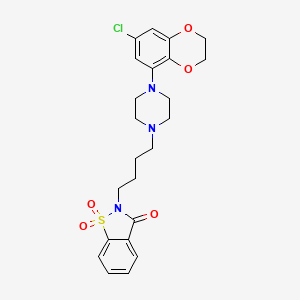
![4-[3-(8-Cyclohexyl-2,6-dioxo-1-propyl-1,2,6,7-tetrahydro-purin-3-yl)-propylcarbamoyl]-benzenesulfonyl fluoride](/img/structure/B1670983.png)
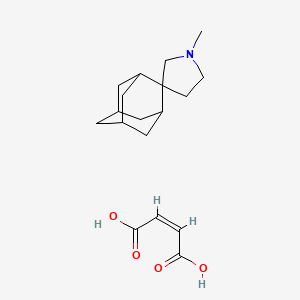
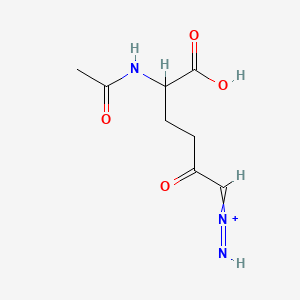
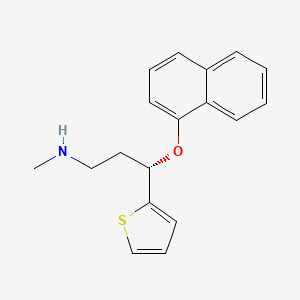
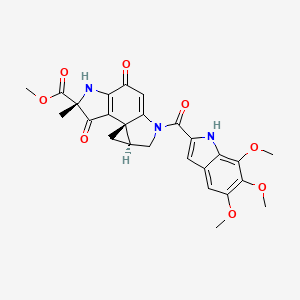
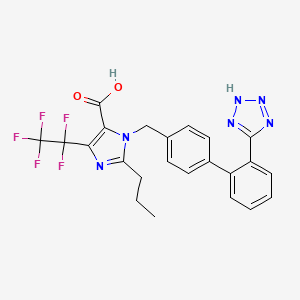
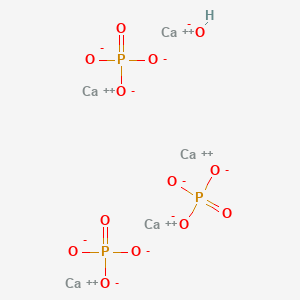
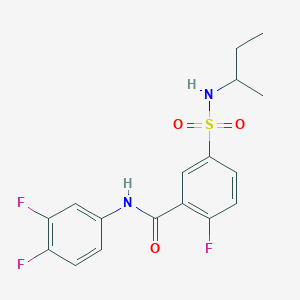
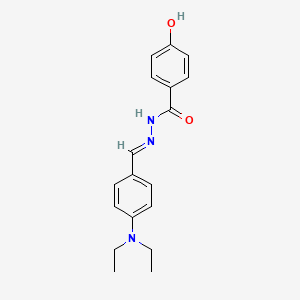
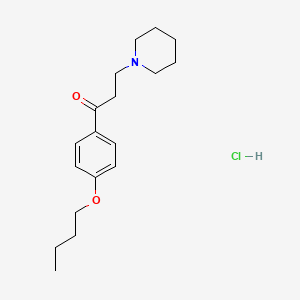
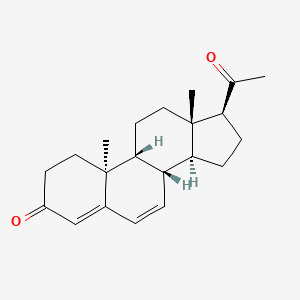
![N-BENZYL-N'-[3-(TRIMETHOXYSILYL)PROPYL]ETHYLENEDIAMINE MONOHYDROCHLORIDE](/img/structure/B1671004.png)
